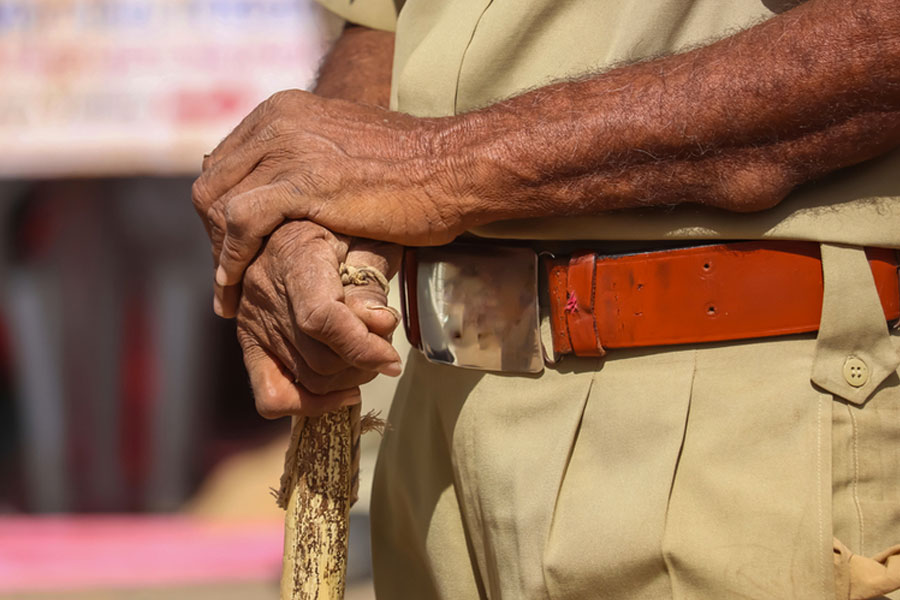 |
| KMSS activists demand protection for Sualkuchi silk industry. File picture |
Yet another precious asset of Assam is under threat. Varieties of silk such as muga and pat, the pride of Assam, are today in danger of being supplanted by spurious surrogates imported from other parts of India. Unscrupulous traders have been selling silk garments made in Varanasi falsely claiming them to be manufactured from Assam silk, with the government being unaware of what has been going on!
It required violent agitation on the part of local weavers of the internationally famous Sualkuchi town for people of Assam to become cognisant of the gravity of the situation and the state government to wake up and take notice. The constant repetition of such a phenomenon in Assam these days — people having to come out onto the streets in order to bring their problems to the establishment’s notice — is not merely indicative of the prevalent bad governance but also blatant failure of the administration to timely address issues plaguing the common man.
Since time immemorial, Assam has been famous for the silk it produced. As is well known, the technique of rearing silkworms and weaving silk cloth began in China, slowly spreading by various routes to different parts of the world. It was brought to the northeastern part of India first by Mongoloid migrants and later by traders. In fact, anthropologists of this region such as R.M. Nath conjecture that the word kirata, as the Mongoloid society concentrated in the Northeast in ancient times was called by the people of mainland India, itself comes from sirkek, the original Mongolian word for silk, and similar derivative words in other languages.
“In ancient times, traders from different parts of Tibet, central Asia and China flocked to Assam through various routes and, as they traded mostly in silk, they were generally called seres-cirrahadoi-syrites-cirata-kirata (The Background of Assamese Culture, R.M. Nath).
Authorities such as Suniti Kumar Chatterji, in his book The Place of Assam in the History and Civilisation of India, also refer to the importance of silk in trade between India and China in ancient times, with Assam being the primary passage.
“Tsang China and Sassanian Persia were the only great states in Asia which India had direct contact with those days, and direct contact with China was effected by land route only through Assam... Evidently the Mongoloid kinship of the people of Assam with that of China and of the intermediate lands served as a link… But prior to that, as the report of the Chinese military man, political officer and explorer Chang K’ien of the 2nd century BC made it clear, there was a trade route from Assam to southwest China, officially not known to or recognised by the Chinese government, through which Chinese manufactured goods like silk cloth and bamboo flutes came to India, to be exported again through her northwestern trade routes to central Asia. The art of rearing silkworm and manufacturing silk as well as weaving silk into cloth may very well have first come to Assam and India through this route…” the book says.
There are numerous other references to indicate that silk and Assam have been interrelated since age-old times, with the Sadiya-Yunan “silk route” being known to the earliest societies of the region, one of the major routes for migration as well as culture-transfer. Some references indicate that the artisans of Pragjyotishpur and Kamarupa, as Assam was known in ancient and medieval times, had attained all-India fame for their craftsmanship, particularly in products involving ivory, silk, bamboo and cane.
For example, according to the Harshacharita, the gifts given by the ruler of Kamarupa, Bhaskarvarman, to Harshavardhana testified to the richness of artistic and economic product of Assam those days and included, amongst a host of other items, “a white silk umbrella” and “silken towels”. It is extremely interesting to note that, unlike the post-Independent political entities in Assam, whose neglect of traditional crafts and their practitioners has led to the present woeful state of affairs, the Ahom administration in Assam enacted strict rules to protect indigenous economic activities.
Mughal historian Shihabuddin records that the Ahom royalty “did not allow foreigners to enter their land, nor permit any of their own subjects to go out of it. Formerly, once a year, by the order of the Raja, a party used to go for trade to their frontier near Gauhati; they gave gold, musk, aloe wood, pepper, spikenard and silk cloth in exchange for salt, saltpetre, sulphur and certain other products of India.”
Also, since ancient times, it was well known to the rest of India that due to climatic and biotic factors Assam silk, especially the varieties muga and pat, was unique. Shihabuddin’s account testifies to the fact that since Assam silk was so different from the silk whose roots lay elsewhere, it was in great demand. The same historian also records that “flowered silk, velvet, tat-band and other kind of silk stuff are excellently woven here”.
There too were many references in the Imperial Gazetteers to the importance silk enjoyed in the economy of this region right till Independence. We talk of British imperialists and their colonial pattern of exploitation, yet traditional craftsmanship and production of unique items such as Assam silk thrived during their rule. The rot began to set in only after India became “Independent”, when enterprising traders in mass-manufactured goods from other parts of India began to intrude into this region’s market. The flood of such goods kickstarted the downward slide of traditional craftsmanship whose proponents could not compete in aspects such as volume and cost of production.
It is not merely the Assam silk industry which has been brought to its knees. Of course, natural course of events has contributed to the destruction of some traditional crafts, which the region had been famous for. The ban on sale of ivory and ivory products, for instance, destroyed an industry, which used to, according to Francis Hamilton, produce “very fine mats, fans and head-scratchers of ivory, all Chinese arts”. Similarly, the eventual drying up of gold particles brought down by rivers such as the Subansiri, led to the demise of the craft of making indigenous ornaments and artefacts with gold available internally.
But it has been entirely due to official apathy and lack of support which has resulted in the languishing of other economic contributors such as cottage handloom, brassware, bell metal and ironware industries. The Assamese people too are to be faulted — they have gone for the cheapness slogan and patronised gamosas and xorais made outside over locally made ones, making it inevitable that indigenous cottage industry would be endangered.
However, even during the post-Independence period, Assam’s silk industry had been an exception, keeping as it did the flag of Assamese craftsmanship flying and doing the state proud. The hardworking loom-wielders of Sualkuchi in particular have been at the forefront of this endeavour. Yet, apparently, the rot had been setting in underneath of late and an industry which needed protection from mass-manufactured surrogates from outside was left to fend on its own by a lackadaisical government rather than be empowered with safeguards and assistance.
The issue here is even greater than the fact that over 25,000 people are engaged in the silk industry and Sualkuchi plays a significant role in Assam’s economy by producing on its own silk-fabrics valued at around Rs 100 crore per annum. The entire Assamese community should lend its support to the industry while the government must take immediate positive steps to safeguard one of our most invaluable assets.
One needs to bear in mind that Assam silk is not merely an item of commerce. It is a symbol of our national identity, a heritage that is millennia old. Thus the loss of our silken legacy would be the loss of a piece of our history.









